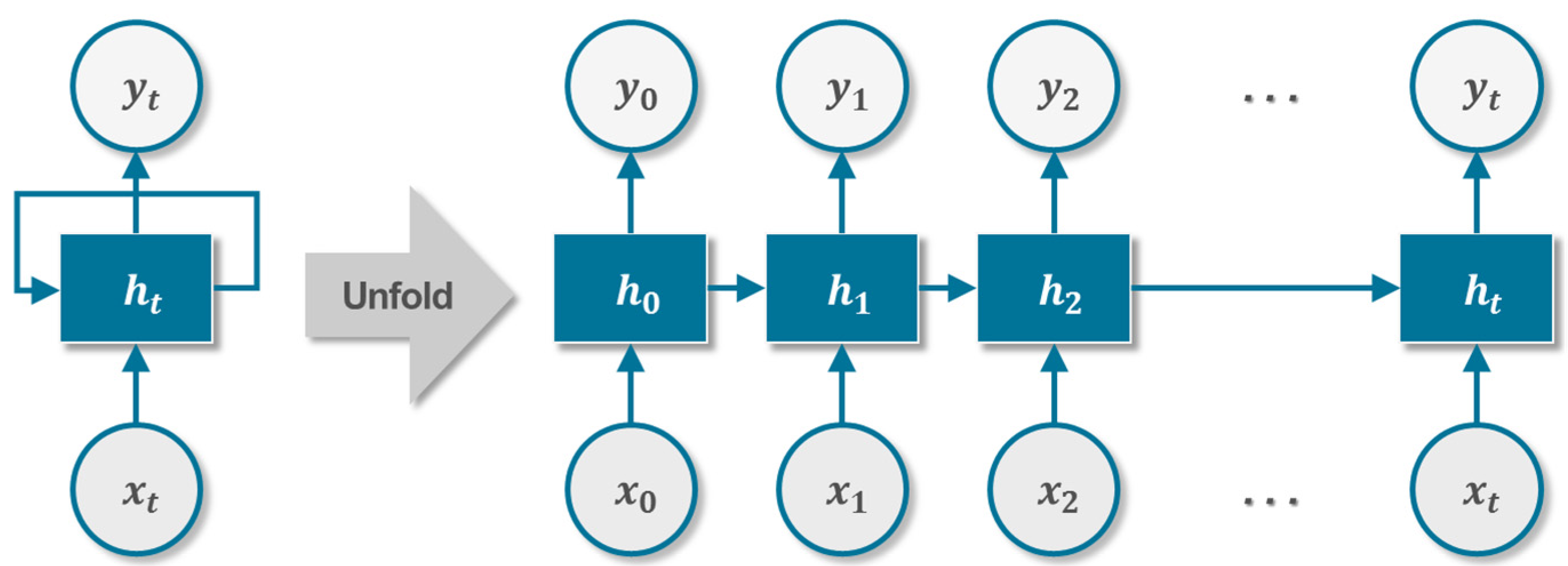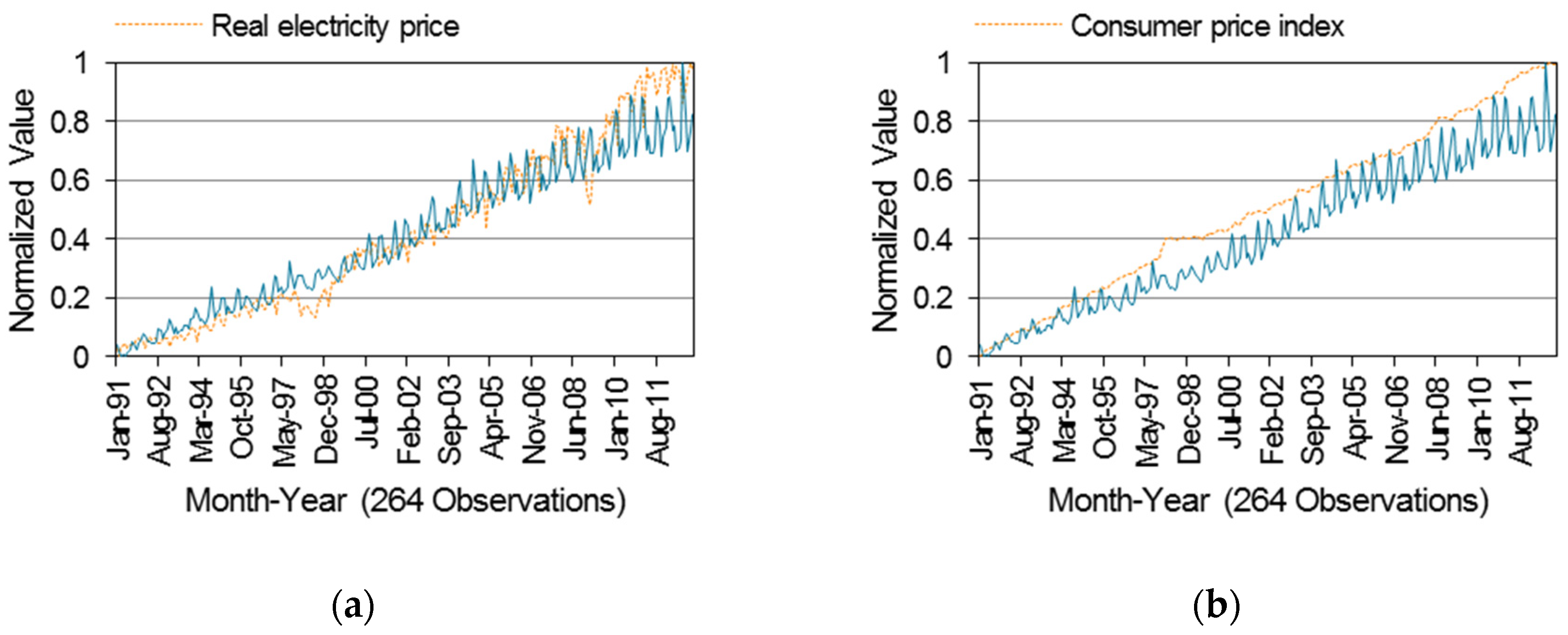A Deep Learning Approach to Forecasting Monthly Demand for Residential–Sector Electricity
Abstract
1. Introduction
2. Related Works
3. Long Short-Term Memory
4. Experiments
4.1. Dataset
4.2. Implementation
4.3. Benchmark Models
4.3.1. Support Vector Regression
4.3.2. Artificial Neural Networks
4.3.3. Autoregressive Integrated Moving Average (ARIMA)
4.3.4. Multiple Linear Regression (MLR)
4.4. Performance Measures
5. Results and Discussion
6. Conclusions
Author Contributions
Funding
Conflicts of Interest
References
- Zhou, K.; Yang, S.; Shao, Z. Household monthly electricity consumption pattern mining: A fuzzy clustering-based model and a case study. J. Clean. Prod. 2017, 141, 900–908. [Google Scholar] [CrossRef]
- Son, H.; Kim, C. Short-term forecasting of electricity demand for the residential sector using weather and social variables. Resour. Conserv. Recycl. 2017, 123, 200–207. [Google Scholar] [CrossRef]
- Vu, D.H.; Muttaqi, K.M.; Agalgaonkar, A.P.; Bouzerdoum, A. Short-term electricity demand forecasting using autoregressive based time varying model incorporating representative data adjustment. Appl. Energy 2017, 205, 790–801. [Google Scholar] [CrossRef]
- IEA. World Energy Outlook 2019; IEA: Paris, France, 2019. Available online: https://www.iea.org/reports/world-energy-outlook-2019 (accessed on 30 March 2020).
- Chen, Y.-T. The factors affecting electricity consumption and the consumption characteristics in the residential sector—A case example of Taiwan. Sustainability 2017, 9, 1484. [Google Scholar] [CrossRef]
- Lusis, P.; Khalilpour, K.R.; Andrew, L.; Liebman, A. Short-term residential load forecasting: Impact of calendar effects and forecast granularity. Appl. Energy 2017, 205, 654–669. [Google Scholar] [CrossRef]
- Al-Musaylh, M.S.; Deo, R.C.; Adamowski, J.F.; Li, Y. Short-term electricity demand forecasting with MARS, SVR and ARIMA models using aggregated demand data in Queensland, Australia. Adv. Eng. Inform. 2018, 35, 1–16. [Google Scholar] [CrossRef]
- Bunnoon, P.; Chalermyanont, K.; Limsakul, C. Multi-substation control central load area forecasting by using HP-filter and double neural networks (HP-DNNs). Int. J. Electr. Power Energy Syst. 2013, 44, 561–570. [Google Scholar] [CrossRef]
- Hamzaçebi, C. Primary energy sources planning based on demand forecasting: The case of Turkey. J. Energy S. Afr. 2016, 27, 1–10. [Google Scholar] [CrossRef]
- Guo, H.; Chen, Q.; Xia, Q.; Kang, C.; Zhang, X. A monthly electricity consumption forecasting method based on vector error correction model and self-adaptive screening method. Int. J. Electr. Power Energy Syst. 2018, 95, 427–439. [Google Scholar] [CrossRef]
- Längkvist, M.; Karlsson, L.; Loutfi, A. A review of unsupervised feature learning and deep learning for time-series modeling. Pattern Recognit. Lett. 2014, 42, 11–24. [Google Scholar] [CrossRef]
- Fan, C.; Xiao, F.; Zhao, Y. A short-term building cooling load prediction method using deep learning algorithms. Appl. Energy 2017, 195, 222–233. [Google Scholar] [CrossRef]
- Berriel, R.F.; Lopes, A.T.; Rodrigues, A.; Varejão, F.M.; Oliveira-Santos, T. Monthly energy consumption forecast: A deep learning approach. In Proceedings of the 2017 International Joint Conference on Neural Network, Anchorage, AK, USA, 14–19 May 2017; pp. 4283–4290. [Google Scholar]
- Chandramitasari, W.; Kurniawan, B.; Fujimura, S. Building deep neural network model for short term electricity consumption forecasting. In Proceedings of the 2018 International Symposium on Advanced Intelligent Informatics, Yogyakarta, Indonesia, 29–30 August 2018; pp. 43–48. [Google Scholar]
- Nair, A.S.; Hossen, T.; Campion, M.; Ranganathan, P. Optimal operation of residential EVs using DNN and clustering based energy forecast. In Proceedings of the 2018 North American Power Symposium, Fargo, ND, USA, 9–11 September 2018; pp. 1–6. [Google Scholar]
- Balaji, A.J.; Ram, D.S.H.; Nair, B.B. A deep learning approach to electric energy consumption modeling. J. Intell. Fuzzy Syst. 2019, 36, 4049–4055. [Google Scholar] [CrossRef]
- Bedi, J.; Toshniwal, D. Deep learning framework to forecast electricity demand. Appl. Energy 2019, 238, 1312–1326. [Google Scholar] [CrossRef]
- Kim, T.-Y.; Cho, S.-B. Predicting residential energy consumption using CNN-LSTM neural networks. Energy 2019, 182, 72–81. [Google Scholar] [CrossRef]
- LeCun, Y.; Bengio, Y.; Hinton, G. Deep learning. Nature 2015, 521, 436–444. [Google Scholar] [CrossRef]
- Chung, J.; Gulcehre, C.; Cho, K.; Bengio, Y. Empirical evaluation of gated recurrent neural networks on sequence modeling. arXiv 2014, arXiv:1412.3555. [Google Scholar]
- Wang, H.; Yang, Z.; Yu, Q.; Hong, T.; Lin, X. Online reliability time series prediction via convolutional neural network and long short term memory for service-oriented systems. Knowl. Based Syst. 2018, 159, 132–147. [Google Scholar] [CrossRef]
- Bengio, Y.; Simard, P.; Frasconi, P. Learning long-term dependencies with gradient descent is difficult. IEEE Trans. Neural Netw. 1994, 5, 157–166. [Google Scholar] [CrossRef]
- Kraus, M.; Feuerriegel, S. Decision support from financial disclosures with deep neural networks and transfer learning. Decis. Support Syst. 2017, 104, 38–48. [Google Scholar] [CrossRef]
- Graves, A.; Mohamed, A.R.; Hinton, G. Speech recognition with deep recurrent neural networks. In Proceedings of the IEEE International Conference on Acoustics, Speech and Signal Processing, Vancouver, BC, Canada, 26–31 May 2013; pp. 6645–6649. [Google Scholar]
- Guo, L.; Li, N.; Jia, F.; Lei, Y.; Lin, J. A recurrent neural network based health indicator for remaining useful life prediction of bearings. Neurocomputing 2017, 240, 98–109. [Google Scholar] [CrossRef]
- Ke, J.; Zheng, H.; Yang, H.; Chen, X.M. Short-term forecasting of passenger demand under on-demand ride services: A spatio-temporal deep learning approach. Transp. Res. Part C Emerg. Technol. 2017, 85, 591–608. [Google Scholar] [CrossRef]
- Zhang, D.; Lindholm, G.; Ratnaweera, H. Use long short-term memory to enhance Internet of Things for combined sewer overflow monitoring. J. Hydrol. 2018, 556, 409–418. [Google Scholar] [CrossRef]
- Kavaklioglu, K.; Ceylan, H.; Ozturk, H.K.; Canyurt, O.E. Modeling and prediction of Turkey’s electricity consumption using artificial neural networks. Energy Convers. Manag. 2009, 50, 2719–2727. [Google Scholar] [CrossRef]
- Swan, L.G.; Ugursal, V.I. Modeling of end-use energy consumption in the residential sector: A review of modeling techniques. Renew. Sustain. Energy Rev. 2009, 13, 1819–1835. [Google Scholar] [CrossRef]
- Aroonruengsawat, A.; Auffhammer, M. Impacts of Climate Change on Residential Electricity Consumption: Evidence from Billing Data; Chapter in NBER book The Economics of Climate Change: Adaptations Past and Present; Libecap, G.D., Steckel, R.H., Eds.; University of Chicago Press: Chicago, IL, USA, 2011; pp. 311–342. [Google Scholar]
- Apadula, F.; Bassini, A.; Elli, A.; Scapin, S. Relationships between meteorological variables and monthly electricity demand. Appl. Energy 2012, 98, 346–356. [Google Scholar] [CrossRef]
- Hondroyiannis, G. Estimating residential demand for electricity in Greece. Energy Econ. 2004, 26, 319–334. [Google Scholar] [CrossRef]
- Valor, E.; Meneu, V.; Caselles, V. Daily air temperature and electricity load in Spain. J. Appl. Meteorol. 2001, 40, 1413–1421. [Google Scholar] [CrossRef]
- Sailor, D.J.; Muñoz, J.R. Sensitivity of electricity and natural gas consumption to climate in the USA—Methodology and results for eight states. Energy 1997, 22, 987–998. [Google Scholar] [CrossRef]
- Chollet, F. Keras. Available online: https://github.com/fchollet/keras (accessed on 30 March 2020).
- Kingma, D.P.; Ba, J. Adam: A method for stochastic optimization. arXiv 2014, arXiv:1412.6980. [Google Scholar]
- Müller, K.R.; Smola, A.J.; Rätsch, G.; Schölkopf, B.; Kohlmorgen, J.; Vapnik, V. Predicting time series with support vector machines. In Proceedings of the 7th International Conference on Artificial Neural Networks, Lausanne, Switzerland, 8–10 October 1997; pp. 999–1004. [Google Scholar]
- Massidda, L.; Marrocu, M. Decoupling weather influence from user habits for an optimal electric load forecast system. Energies 2017, 10, 2171. [Google Scholar] [CrossRef]
- Sousa, J.C.; Jorge, H.M.; Neves, L.P. Short-term load forecasting based on support vector regression and load profiling. Int. J. Energy Res. 2014, 38, 350–362. [Google Scholar] [CrossRef]
- Chen, Y.; Xu, P.; Chu, Y.; Li, W.; Wu, Y.; Ni, L.; Bao, Y.; Wang, K. Short-term electrical load forecasting using the support vector regression (SVR) model to calculate the demand response baseline for office buildings. Appl. Energy 2017, 195, 659–670. [Google Scholar] [CrossRef]
- Khosravi, A.; Koury, R.N.N.; Machado, L.; Pabon, J.J.G. Prediction of hourly solar radiation in Abu Musa Island using machine learning algorithms. J. Clean. Prod. 2018, 176, 63–75. [Google Scholar] [CrossRef]
- Son, H.; Kim, C. Early prediction of the performance of green building projects using pre-project planning variables: Data mining approaches. J. Clean. Prod. 2015, 109, 144–151. [Google Scholar] [CrossRef]
- Alani, A.Y.; Osunmakinde, I.O. Short-term multiple forecasting of electric energy loads for sustainable demand planning in smart grids for smart homes. Sustainability 2017, 9, 1972. [Google Scholar] [CrossRef]
- Adamowski, J.; Chan, H.F.; Prasher, S.O.; Ozga-Zielinski, B.; Sliusarieva, A. Comparison of multiple linear and nonlinear regression, autoregressive integrated moving average, artificial neural network, and wavelet artificial neural network methods for urban water demand forecasting in Montreal, Canada. Water Resour. Res. 2012, 48. [Google Scholar] [CrossRef]
- Kia, A.N.; Fathian, M.; Gholamian, M.R. Using MLP and RBF neural networks to improve the prediction of exchange rate time series with ARIMA. Int. J. Inform. Electron. Eng. 2012, 2, 543–546. [Google Scholar] [CrossRef]
- Dudek, G. Pattern-based local linear regression models for short-term load forecasting. Electr. Power Syst. Res. 2016, 130, 139–147. [Google Scholar] [CrossRef]
- Hu, Z.; Bao, Y.; Xiong, T. Comprehensive learning particle swarm optimization based memetic algorithm for model selection in short-term load forecasting using support vector regression. Appl. Soft Comput. 2014, 25, 15–25. [Google Scholar] [CrossRef]
- Lewis, C.D. Industrial and Business Forecasting Methods: A Practical Guide to Exponential Smoothing and Curve Fitting; Butterworth Scientific: London, UK; Boston, MA, USA, 1982. [Google Scholar]
- Hamzacebi, C.; Es, H.A. Forecasting the annual electricity consumption of Turkey using an optimized grey model. Energy 2014, 70, 165–171. [Google Scholar] [CrossRef]
- Jiang, Y.; Yao, Y.; Deng, S.; Ma, Z. Applying grey forecasting to predicting the operating energy performance of air cooled water chillers. Int. J. Refrig. 2004, 27, 385–392. [Google Scholar] [CrossRef]
- McSharry, P.E.; Bouwman, S.; Bloemhof, G. Probabilistic forecasts of the magnitude and timing of peak electricity demand. IEEE Trans. Power Syst. 2005, 20, 1166–1172. [Google Scholar] [CrossRef]









| Variable Name | Unit |
|---|---|
| Social variables | |
| Real electricity price | won/ kWh |
| Consumer price index | – |
| Weather variables | |
| Wind speed | m/s |
| Vapor pressure | 0.1 hPa |
| Total cooling degree days | Degree-days |
| Mean temperature | °C |
| Maximum temperature | °C |
| Cooling degree days | Degree-days |
| Global solar radiation | 0.01 MJ/m2 |
| Daylight time | hours |
| Method | Proposed | SVR | ANN | ARIMA | MLR | |
|---|---|---|---|---|---|---|
| Measure | ||||||
| MAE | 3,808.67 | 113,870.67 | 522,503.25 | 242,005.30 | 361,170.52 | |
| RMSE | 6,446.66 | 149,287.54 | 633,073.65 | 261,671.62 | 426,779.00 | |
| MAPE | 0.07 | 2.13 | 9.92 | 4.71 | 7.15 | |
| C | 0.02 | 0.37 | 1.01 | 0.35 | 0.79 | |
| MBE | 930.25 | 45,695.11 | 500,754.67 | 224,571.82 | 300,159.62 | |
| UPA in 2011 | 0.02 | 2.11 | 12.16 | 2.10 | −0.41 | |
| UPA in 2012 | −0.44 | −5.89 | 14.03 | −2.57 | −5.83 | |
© 2020 by the authors. Licensee MDPI, Basel, Switzerland. This article is an open access article distributed under the terms and conditions of the Creative Commons Attribution (CC BY) license (http://creativecommons.org/licenses/by/4.0/).
Share and Cite
Son, H.; Kim, C. A Deep Learning Approach to Forecasting Monthly Demand for Residential–Sector Electricity. Sustainability 2020, 12, 3103. https://doi.org/10.3390/su12083103
Son H, Kim C. A Deep Learning Approach to Forecasting Monthly Demand for Residential–Sector Electricity. Sustainability. 2020; 12(8):3103. https://doi.org/10.3390/su12083103
Chicago/Turabian StyleSon, Hyojoo, and Changwan Kim. 2020. "A Deep Learning Approach to Forecasting Monthly Demand for Residential–Sector Electricity" Sustainability 12, no. 8: 3103. https://doi.org/10.3390/su12083103
APA StyleSon, H., & Kim, C. (2020). A Deep Learning Approach to Forecasting Monthly Demand for Residential–Sector Electricity. Sustainability, 12(8), 3103. https://doi.org/10.3390/su12083103






